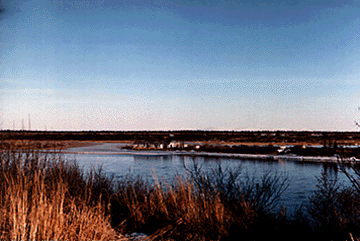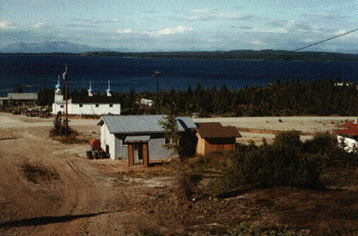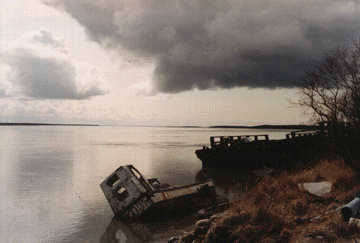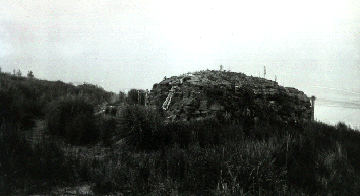In the early 1990s, the National Park Service funded the University of Alaska Fairbanks Oral History Program to conduct interviews with residents of Igiugig, Levelock, Kokhanok and South Naknek about their lives and experiences related to Katmai National Park, its establishment, and subsistence living in the area. The interviews provide glimpses of peoples' lives and the changes they have experienced. Each person was asked to discuss yearly cycles of activities for different times in their lives. Several themes should be noted here. The individuals interviewed have ties to people in other Bristol Bay villages, and they travel to these places often to visit and do subsistence activities. The Bristol Bay fishery has provided summer employment opportunities for at least two generations of men, and for women summer subsistence fishing in Iliamna Lake and on the Kvichak River is a large part of their yearly cycle. The Alakanak or Branch River is often discussed as a destination for seasonal hunting and fishing. In addition, some of the interviews describe changes in weather and animal populations over the narrator's lifetime. Several important management issues are discussed. These include Native concepts of conservation, conflicts with the sport lodges, and overland access to parklands by wheeled vehicles. Each person provides their own perspective on these issues.
Starting in the mid-1990s, computer design and programming was completed by University of Alaska Fairbanks Oral History office staff and the material was put into an HTML-based format for interactive access to the recordings, photographs, maps, and transcripts, but it was only available at the University of Alaska Fairbanks and the Park headquarters in Anchorage. The original Igiugiq portion was completed in the summer and fall of 1995, the Kokhanok and Levelock portions in the fall of 1998 and the winter/spring of 1999, and the South Naknek portion in 1999/2000. In 2003, Marla Statscewich of the Oral History Program updated the program, contacted original project participants about web access, and made it available on the Internet.
 Igiugig Background
Igiugig Background
The Igiugig portion of this project began in December 1994 when community members viewed other Jukebox projects and suggested elders in Igiugig to be interviewed. In March 1995, Bill Schneider, with the University of Alaska Fairbanks Oral History Program, and Don Callaway, with the National Park Service, conducted interviews with residents of Igiugig. The plan was to have people tell their life stories and provide personal perspectives on their lifetimes of hunting, fishing, and trapping in and around Katmai National Park. Mary Olympic and her sister, Dallia Andrew, grew up at Kukaklek Lake where their father was a reindeer herder, and they speak about their ties to that area in the map portion of the program.
In addition to the life story interviews, there is a tour of Anne and George Wilson's yard, narrated by George. The purpose of this slide/tape format is to provide a view of some of the equipment a well-respected community member has used over the years. Some of it goes back to the sailing days, such as wooden rudders and water jugs, while other items like snowmachines and four-wheelers depict the evolution of motorized transportation and winter overland travel, and illustrate some of the points George makes in his interviews.
The program also includes a narrated slide/tape presentation by Mary Olympic of historic photographs that hang in the school. These include subsistence activities, commercial fishing, and the church.
Kokhanok Background
The Kokhanok portion of this project began in August 1997 when Judith Morris, a subsistence researcher working for Alaska Department of Fish and Game conducted interviews with residents of Kokhanok, many of whom she had worked with previously. The plan was to have people tell their life stories and provide personal perspectives on their lifetimes of hunting, fishing, and trapping in and around Katmai National Park. Then in November 1999, Bill Schneider, with the University of Alaska Fairbanks Oral History Program, and Don Callaway, with the National Park Service, conducted interviews with Gabby Gregory, Gregory Andrew, Garith Nielsen, John Nelson Jr., and a second interview with Danny Roehl.
In addition to the life story interviews, there is a short slideshow providing a visual introduction to the community of Kokhanok. John Branson, a historian for Lake Clark National Park and Preserve, provided the historic photos and all of the slideshow photo captions.
 Levelock Background
Levelock Background
The Levelock portion of this project began in 1996 when the idea was introduced to the community. Then in May 1998, Bill Schneider, with the University of Alaska Fairbanks Oral History Program, and Don Callaway, with the National Park Service, conducted interviews with residents of Levelock. The plan was to have people tell their life stories and provide personal perspectives on their lifetimes of hunting, fishing, and trapping in and around Katmai National Park.
In addition to the life story interviews, there is a brief slideshow which provides a visual overview of the community and the people interviewed.
South Naknek Background
The South Naknek portion of this project began in the spring of 1996 when the idea was introduced to the community and in January 1998 when Patricia Partnow, a consulting anthropologist from Anchorage, returned to celebrate Slavi (Russian Christmas) with the community. In January and March 1998, Patricia Partnow, who previously had worked with residents of Perryville and the Chigniks (many of whose ancestors were originally from the Katmai coast), and Mary Jane Nielsen, General Manager of the Alaska Peninsula Corporation, a resident of South Naknek, and founding member of the Council of Katmai Descendants (a group interested in preserving the history and heritage of the Katmai area), conducted interviews with residents of South Naknek and King Salmon.
The people of South Naknek and King Salmon still depend on the resources of Bristol Bay, Naknek River, and Naknek Lake. People continue to hunt and gather plant foods. However, the most important subsistence activity continues to revolve around fishing. Even those who fish commercially for herring and salmon put up fish for their own use each year. These interviews describe each person's experiences at the fish camp, called "Kittiwik." Interviewees also talk about their yearly subsistence cycles within the park and in the surrounding areas, from plant collection to trapping to hunting and fishing. They tell about how they prepared, used, and distributed the resources.
South Naknek is intimately tied with the history of Katmai National Park. Already a thriving commercial fishing town at the time of the Katmai eruption in 1912, the community was often visited by Alutiiq residents of the villages located on the shores of Naknek Lake. In fact, it was eventually in South Naknek that the refugees from those villages settled after the eruption.
 The abandoned village that is now called "Old Savonoski," had been the home of Pelagia and her husband American Pete at the time of the eruption. The two fled down the Naknek River and established a new village on its south bank, which they called "New Savonoski." After American Pete died, Pelagia and her second husband Nick (called "One-Arm Nick") Melgenak were key individuals in perpetuating the culture and subsistence practices in the area around their old home. Through the years they took in a dozen or more children whose parents had died or were unable to care for them. These youngsters, including Vera Angasan and Teddy Melgenak who are interviewed in this project, went back each summer and fall to a fishcamp at the mouth of the Brooks River near the current center of activity in the park, Brooks Camp, to harvest red salmon, pick berries, and hunt bear and moose.
The abandoned village that is now called "Old Savonoski," had been the home of Pelagia and her husband American Pete at the time of the eruption. The two fled down the Naknek River and established a new village on its south bank, which they called "New Savonoski." After American Pete died, Pelagia and her second husband Nick (called "One-Arm Nick") Melgenak were key individuals in perpetuating the culture and subsistence practices in the area around their old home. Through the years they took in a dozen or more children whose parents had died or were unable to care for them. These youngsters, including Vera Angasan and Teddy Melgenak who are interviewed in this project, went back each summer and fall to a fishcamp at the mouth of the Brooks River near the current center of activity in the park, Brooks Camp, to harvest red salmon, pick berries, and hunt bear and moose.
Some themes came up in every interview. These were the strong emotional and cultural ties of the people with the region, the effects the creation of the park had on use of the land and its resources, the importance of subsistence today, and the personal ties among the many people who harvested and shared plants and animals. Several participants described their anguish at having to furtively harvest their traditional foods when it was against the law during the middle years of this century. This feeling was exacerbated in 1980 when the park boundaries were expanded to include territory that had previously been outside the park.
In addition to transcripts and recordings of the interviews, this program contains historic photographs from Carvel Zimin's personal collection and a map detailing places in the South Naknek area that are discussed in the interviews.

